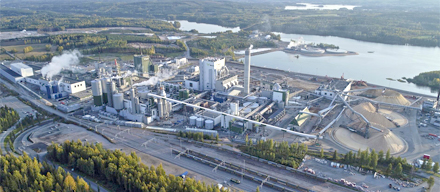
When Australian Paper last year floated the idea of creating a bio-manufacturing operation at its plant, its model was Metsa Group’s new $2 billion Aanekoski mill in Finland. Source: Philip Hopkins for Timberbiz
AP’s probe into building a waste-to-energy plant is an integral part of this investigation, which aims to make the company part of the growing bio-economy.
The 1.2 billion euro Aanekoski bio-product mill is at the cutting edge of this new industry. It began operating in August last year.
Wood pulp and fibre are creating new products such as fibre packages, composites, polymers, pharmaceuticals, cosmetic products and bioenergy.
“The mill is the biggest forest industry investment in the history of Finland,” said Metsa Fibre’s senior vice-president of business development, Kaija Pehu-Lehtonen, in an interview with Daily Timber News in Helsinki.
“It’s also the largest wood-processing facility in the northern hemisphere.”
Jussi Manninen, a senior executive with VTT, Finland’s CSIRO, said Metsa said in 2014 that it was building the bio-mill had a huge psychological effect.
“The company was saying, ‘We believe in this industry, we are going to put down 1.2 billion euros’,” he said. “That was of major importance. The public and industry perception changed.”
Metsa Group employs 9100 people, and its mother company is a co-operative of 104,000 forest owners.
It has five main business areas – wood supply and forest services, engineered wood products, pulp and sawn timber, paperboard, and tissue and cooking paper. The bio-product mill is part of the pulp and timber division, Metsa Fibre, which employs 1200 people and last year had sales of 1.9 billion euros.
Ms Pehu-Lehtonen said Metsa was no longer making printing paper at all. Instead, the wood entering the bio-product mill is processed to pulp, which is used by Metsa Group’s other businesses, or sold to the market and various side streams.
“Bio-products derived from the side streams already account for 20% of the mill’s sales, and the proposition will continue to grow in phases,” she said.
The mill’s side streams included:
- Bioelectricity from dissolved wood.
- Transforming bark into traditional bioenergy but also new biofuels. Half the bark is gasified into renewable fuel for the mill’s own use, while the rest is sold as biofuel.
- Higher value-added products – textiles and bio-composites – from pulp. Bio-composites are mainly used in consumer electronics, construction and the automotive industry, but also in bio-medical engineering and other engineering applications.
- New bio-products from lignin, a big part of the wood. “That is also in our research agenda, but is not yet taking off.”
- Biogas from sludge for traffic fuel or the mill’s own use, and solid biofuel for external power plants.
- Fertiliser and earth works material from dregs and ashes.
- Sulphuric acid and methanol from odorous gases for the mill’s own use.
Ms Pehu-Lehtonen said Metsa Group’s innovation company, Metsa Spring, and its Japanese partner Itochu, would build a demonstration plant to produce a new kind of textile fibres from non-dried pulp next to the Aanekoski bio-product mill.
Mr Manninen said Paptic, a spin-off from VTT, had also produced a prototype fibre bag to replace plastic bags.
The bio-product mill, which does not use fossil fuels, is 240 per cent energy self-sufficient and will generate 2.5 per cent of all electricity in Finland.
“The mill has met expectations. There is always learning and adjustments, but we have the capacity in long run to add to this mill,” she said.
Metsa’s research links include VTT and other outside partners such as universities and technology providers.
“We put the money where we find the best capabilities,” Ms Pehu-Lehtonen said.
Finland’s forestry industry gets two-thirds of its wood from family forest farms, where the average estate is 30 hectares. In Victoria, most native forest, which is mainly hardwood, is owned by the Crown, with softwood sourced from company pine plantations.
Metsa’s environment director, Jussi Ripatti, said the company had up to 35,000 wood procurement contracts each year. “It’s a complex wood supply chain,” he said.
Finland, one-and-a-half times the size of Victoria, has 5.5 million people and is 75 per cent forest. Victoria is one third forest.
Metsa’s wood is 88% certified, most under PEFC (Program for the Endorsement of Forest Certification), the same standard that VicForests has achieved for Victoria’s forests.
About 7% of Finland’s forests are FSC certified. VicForests is trying to achieve FSC certification.
Mr Ripatti said Finland had made great conservation progress, with 12%-13% of the country’s forests now protected – “the highest percentage in Europe at the moment”.
Victoria has 60% of its forests in reserves, with another 34% unavailable because the forest is inaccessible or unsuitable.
The Andrews Government, the Federal Government and the Federal Opposition have all pledged to expand Victoria’s wood resource through plantations, the latter both emphasising farm forestry.





